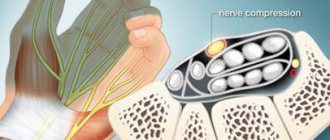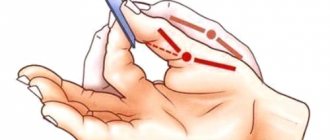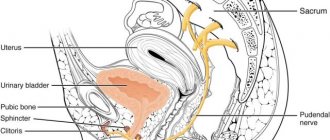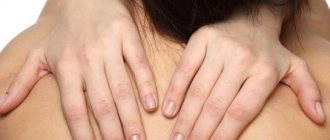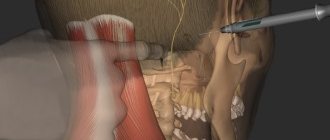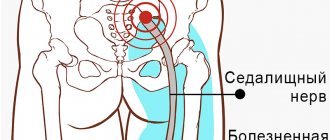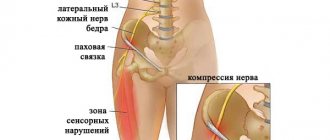In everyday life, pinching of the brachial nerve is of a compressive nature; the condition stabilizes quite quickly after eliminating the traumatic factor. It manifests itself as a feeling of numbness in the thumb, index and middle fingers, tingling in the forearm, and small convulsive muscle twitches.
This pinched nerve in the shoulder joint is not a consequence of pathological changes in the structure of the tissues of the bone articulation. It can be caused by tight clothing, the use of crutches, compression of the shoulder tissues during sleep when choosing the wrong position, etc. Symptoms in this case disappear literally 2-3 hours after restoration of nerve fiber patency.
What to do if the symptoms of a pinched brachial nerve do not go away, what treatment can be used to restore normal innervation of the upper limb? To answer this question, you must first conduct a detailed diagnosis. the fact is that a pinched nerve in the shoulder joint can be a consequence of numerous pathologies, ranging from osteochondrosis of the cervical spine with radicular syndrome, to tenosynovitis or sprain with habitual shoulder dislocation. Only an experienced doctor can determine the exact cause of pinching and inflammation of the brachial nerve.
We invite you to a free consultation with a doctor at our manual therapy clinic. During your appointment, you will be given an accurate diagnosis and effective treatment will be prescribed. You can make an appointment by calling the number listed on the website.
Causes of inflammation and pinching of the nerve of the shoulder joint
Inflammation of the brachial nerve is a serious illness that develops as a compensatory reaction of the body in response to long-term compression (squeezing). To release the nerve fiber tissue, the body in the area of pressure provokes aseptic inflammation with swelling and increased blood supply to the soft tissues. Due to this, the compression is partially relieved, but inflammation begins with its typical symptoms (pain, redness of the skin, local increase in temperature, loss of sensitivity, etc.).
In order to successfully treat inflammation of the nerve of the shoulder joint, it is necessary to identify and eliminate the cause of its compression. Otherwise, rapid progression of the underlying disease is possible. Thus, with developing arthrosis of the shoulder joint, the use of non-steroidal anti-inflammatory drugs certainly relieves pain. But this happens only at an early stage. Then, to block the unpleasant sensations, patients need to either significantly increase the dose of the drug or switch to intra-articular injections of potent corticosteroid drugs. This further accelerates the process of tissue destruction.
The main causes of brachial nerve entrapment are the following conditions (including pathological ones):
- wearing clothing that puts pressure on the shoulder and armpit;
- walking on crutches for a long time;
- “wedding night” syndrome - when a woman’s head rests on a man’s shoulder for a long time (or vice versa);
- shoulder injury, including sprain of the ligamentous apparatus with subsequent scar changes against the background of habitual dislocation;
- excessive physical stress on the muscles of the shoulder and collar area, which can provoke their spastic contraction and compression of the radial and brachial nerves (usually in this condition, pinching is observed symmetrically on both sides);
- deformation of bone and cartilage tissue due to osteoarthritis of the shoulder joint;
- tenosynovitis, bursitis, and other inflammatory processes of surrounding tissues;
- damage to the acromial joint;
- bruises, fractures, carpal tunnel syndrome.
Sometimes the cause of infringement is incorrect posture, the habit of slouching, and even wearing a handbag on a long strap. Therefore, at the first appointment, the doctor conducts a complete survey of the patient to collect anamnesis. By comparing the information received with the existing clinical signs, the doctor will determine the cause of the development of inflammation and pinching of the brachial nerve. Therefore, this specialist will be able to develop an effective course of treatment.
Prevention
Brachial plexus neuropathy is not always treatable. Therefore, to avoid the development of pathology, it is recommended:
- evenly distribute the load on the shoulder joints;
- avoid injury;
- do warm-up exercises before physical activity;
- exercise regularly;
- watch your posture;
- If you have a sedentary lifestyle, take periodic five-minute breaks, during which you should perform simple exercises.
If a nerve in the shoulder is pinched, it is necessary to avoid hypothermia and not take medications without consulting your doctor. The last recommendation is due to the fact that a number of medications provoke intoxication, which contributes to the development of neuralgia.
Symptoms of a pinched nerve in the shoulder joint
Clinical manifestations are divided into acute, subacute and chronic. Acute symptoms of brachial nerve pinching are characteristic of compression resulting from traumatic influence. They may accompany a fracture or dislocation, sprain or rupture of ligamentous tendon tissue.
Subacute manifestations are typical of progressive diseases of the musculoskeletal system. This may be deforming osteoarthritis, glenohumeral periatritis, instability of the head of the humerus, etc.
Chronic manifestations usually occur with cervical osteochondrosis with radicular syndrome, deforming osteoarthritis, and tunnel syndrome. They are characterized by the fact that the pain is dull, not expressed, is constantly present, and due to limited mobility the patient gets used to not noticing these signs.
In general, symptoms of a pinched nerve in the shoulder joint include the following signs of trouble:
- pain of varying intensity (it can be localized in the shoulder, forearm and shoulder blade);
- a crawling sensation on the arm and the area between the shoulder blades;
- decreased range of motion in the elbow and shoulder joints;
- impaired motor activity (innovative or spastic contractures may develop in response to a strong pain reaction);
- inability to spread the fingers in different directions;
- feeling of numbness in the thumb, index and middle fingers.
Acute pain in the shoulder area forces you to unload your arm physically and refuse to use it when performing various operations. Gradually, during a chronic process, plegia and flaccid paralysis are formed, accompanied by muscle weakness and tissue degeneration.
In order to restore normal functioning of the upper limb, efforts must be made as quickly as possible to eliminate compression from the brachial and radial nerves.
Complications after tendinitis
Like any other disease, tendon tendinitis can have complications. It is not difficult to avoid them if you start the right treatment on time. However, it may happen:
- tissue ruptures;
- chronic course of the disease, which is accompanied by constant pain;
- processes of bone tissue proliferation, which lead to inflammation of various types.
Timely examination by a doctor and compliance with all his instructions will minimize the likelihood of complications.
What to do if the brachial nerve is pinched?
A situation where the brachial nerve is pinched requires immediate intervention by medical personnel. Don't try to help yourself. It will likely be necessary to use special techniques to restore the normal position of the humeral head in the joint cavity. Therefore, the first thing to do if the brachial nerve is pinched is to seek medical help.
We are ready to provide assistance with almost any pathology of the musculoskeletal system associated with compression of the nerve fiber. Our manual therapy techniques allow you to quickly and effectively relieve pressure and restore the process of tissue innervation.
What to do at home before seeing a doctor? Calm down and remember what preceded the onset of acute pain. If there was an unnatural movement of the arm and you suspect a dislocation of the joint, then you should immediately seek help at the nearest emergency room or call an emergency medical team. If there was no traumatic impact, then it is advisable to make an appointment with an orthopedist.
Before visiting a doctor, you can only use external non-steroidal anti-inflammatory ointments (Dolgoit, Ortofen, Ketorol, etc.). We recommend avoiding ointments with a warming effect. If there is tissue microtrauma, the warming effect can provoke increased internal bleeding. This will lead to the formation of a hematoma of impressive size.
Be sure to provide complete physical rest to your hand. You should not try to “develop” the joint on your own or make movements that cause pain and discomfort. This should only be done under the guidance of an experienced physical therapist. Otherwise, you risk shoulder dislocation or bone destruction.
Stages of tendinitis
Modern medicine distinguishes several stages of this disease. These include:
- Acute phase. The damaged area of the body causes severe pain. If a person feels discomfort in a calm state, then with physical activity it develops into unbearable acute pain;
- Subacute phase. The pain persists and is accompanied by swelling. Movements become difficult and limited;
- Chronic phase. Tissue degeneration occurs. Pain becomes a constant “guest”, as does stiffness.
Before treating a pinched nerve in the shoulder joint
Before treating the brachial nerve, it is necessary to find out the cause of its damage. Consistently eliminating all potential causes will result in the compression of the nerve fiber being eliminated. This will lead to a gradual restoration of dystrophically altered fibers. But in some cases, regeneration will require longer treatment.
It is important, before treating a pinched brachial nerve, to conduct a full differential diagnosis. In the case of a traumatic, inflammatory and degenerative process of tissue change, the symptoms will be similar to each other, but treatment methods can differ radically.
Therefore, before treating a pinched nerve in the shoulder joint, you need to consult an experienced doctor. You may also need to take x-rays of your shoulder, elbow, and wrist joints. If this does not allow for an accurate diagnosis, then it is recommended to do an MRI or CT scan. In complex diagnostic cases, as well as in the presence of sufficient indications for surgical intervention, arthroscopy of the shoulder joint is performed. During this endoscopic operation, manipulations can be performed to restore the integrity of damaged tissue.
Diagnosis of pathology
Neuralgia is often confused with neuritis (the development of an inflammatory process) because they have similar symptoms. Despite the fact that these are different pathologies, with inadequate and untimely treatment, there is a high probability that the pinched nerve will become inflamed. In addition, a pinched nerve has similar symptoms in various disorders of the cardiovascular system, when there are problems with blood circulation and oxygen supply to the fibers.
To establish that the source of pain and other symptoms lies precisely in the pinching, you need to contact a qualified specialist. At the initial appointment, he will listen to all the patient’s complaints, collect anamnesis and conduct a neurological examination. To do this, finger sensitivity and tendon reflexes will be tested. If there is pinching, the patient will not be able to spread the thumb and little finger apart. Problems will also arise with clenching all your fingers into a fist.
The essence of another diagnostic method is to check for hanging hand syndrome. It will be confirmed in the situation if, with the arm extended in a horizontal position, a person is unable to hold the hand parallel to the floor. Additionally, in order to make a reliable diagnosis and differentiate it from other diseases, a neurologist will prescribe an instrumental examination. It will also help determine the underlying cause of the nerve compression. The following techniques may be prescribed to the patient:
- X-ray examination. This is the simplest type of instrumental examination. Doctors prescribe it first. The study does not take much time and has virtually no contraindications. Based on the results of the obtained x-ray, it is possible to detect a number of degenerative diseases, osteophytes, cysts and other tumors (benign and malignant);
- ultrasonography. As a rule, it is resorted to only when there are suspicions of disturbances in the functioning of the cardiovascular system. This technique is quite mobile, accessible, it is characterized by the absence of painful sensations and the speed of implementation;
- computed tomography (CT). This is a more informative technique compared to radiographic examination. It clearly visualizes the bone structures of the spine and allows one to determine the possibility of bone displacement. Computed tomography is highly effective and allows you to determine the degree of nerve pinching;
- magnetic resonance imaging (MRI). This diagnostic method is completely safe for the patient. There are no painful sensations during the examination. The number of contraindications is minimal. Magnetic resonance imaging makes it possible to detect the cause that provoked the development of the disease. It well reflects the structure of the tissues of the shoulder joint and the condition of nearby tissues.
Laboratory testing is used as an auxiliary diagnostic method, since it does not provide a detailed picture of the clinical picture. However, a general blood test can detect neuritis (the development of an inflammatory process). In this case, the number of leukocytes in the patient's blood will increase.
Treatment of a pinched nerve in the shoulder joint
To treat a pinched brachial nerve, both conservative and surgical methods can be used. In any case, treatment for a pinched nerve in the shoulder joint should begin as soon as possible after the onset of typical clinical symptoms; the longer the compression of the nerve fiber continues, the higher the chances of starting atrophic processes. This will lead to the limb losing the ability to perform certain actions. Both the first three fingers of the hand and the arm as a whole may be paralyzed.
Manual therapy allows the use of techniques in the treatment of the nerve of the shoulder joint that, without pharmacological or surgical effects, trigger regeneration processes and completely eliminate pain. In order to eliminate pain, you need to eliminate pressure. This can be done using traction, osteopathy, massage and manual therapy.
Then, techniques are used to provide complete treatment for the underlying disease of the shoulder joint that causes compression of the nerves. For this purpose, kinesitherapy, therapeutic exercises, osteopathy, reflexology, laser therapy and much more are prescribed.
The course of treatment is developed individually. So if you are experiencing shoulder or forearm pain, schedule a free consultation with our manual therapy clinic. After the examination and diagnosis, you will be given individual recommendations for treatment.
Tendonitis in pregnant women and its features
This disease is a frequent “guest” of women who are expecting a child. If there are suspicions, then it is preferable not to do an x-ray or computed tomography during the examination. Any medications that a pregnant woman will take must be prescribed by the attending physician and also agreed with the gynecologist. In this case, self-medication will be dangerous not only for the patient, but also for her unborn child.
When the first symptoms of tendinitis appear, doctors advise limiting yourself to physical therapy, rest, and applying cold compresses to the affected area. If you need to relieve inflammation and reduce pain, ointments based on painkillers are prescribed.
If the problem enters an acute phase, the doctor may resort to immobilization of the joint. Antibiotics may be prescribed, but only if a bacterial infection is found and other treatments have been ineffective. In the most extreme cases, surgery is performed on the joint.
